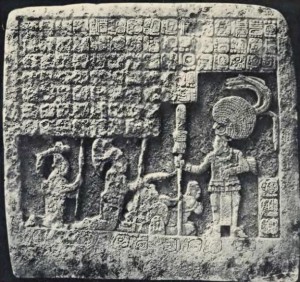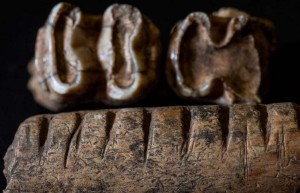Sahara Pradhan ’15, has been heavily involved in VHP since her freshman year. She has served as the Education initiative director, the Outreach director and as the co-president for Haiti Operations
International Profile – Ruoyu (Lucy) Li
Ruoyu Li, Class of 2019
Today we bring to you the coolest fresh(wo)man apprentice from OIS!
Ruoyu (Lucy) Li, Class of 2019
Beijing, China
Undecided, but interest in Art History
Hello Ruoyu! International kids often have cool names; can you tell us how you got yours?
Li is my family name and “ruo” means appear to look like, and “yu” means sunlight. So “Ruoyu” means someone who looks like sunlight
Easy Beef Chili recipe
Ingredients (for 4 people)
Butter/Oil
picture from marmiton.org
2 onions
3 cloves of garlic
500-700g of ground beef
1 tb chili powder
2 tb cumin powder
optional: 1 tb (or more if you like to eat spicy!) cayenne pepper or chili flakes
~80g tomato past
1-2 tins of red or black bean
1 beef stock cube
salt & pepper
Directions
In a large pot on medium/high heat, cook the onions and garlic in the oil or butter
The Ethics of Excavation
The excavation and analysis of human remains has long been a staple in archaeology. Archaeologists can learn a lot about a civilization from the remains that they have left and how they take care of their remains. You can tell a lot about the values of a civilization based on their burial rituals and treatment of their own remains. And through the use of forensic archaeology, human remains can be used to give insight into more recent events. With forensic archaeology, more recent remains can be used as evidence in criminal cases. Although the use of excavated remains is a fundamental part of archaeology, and has provided a great deal of information to archaeologist it does not come without controversy. Many people object to the excavation of remains because it does not show respect to the person who died.

Remains of Army Discovered in bog. Gave Archaeologists Information about Teutonic Massacre. Use of Human Remains
Forensic Archaeology is a subset of archaeology that uses artifacts in order to help solve criminal cases. In forensic archaeology, human remains are very important. Archaeologists utilize human remains to determine information about a deceased person from before the person dies. This information age, sex, time of death, method of death, etc. can be crucial to a criminal case. In many cases criminals would have gotten away without being caught without the use of forensic anthropology. But does the good that comes from the use of human remains outweigh the negatives? Some say no.
Since the first excavations of human remains have been conducted there has been controversy. In many cultures, people are taught to show respect to the dead. It is disrespectful to disturb the remains of an already buried person. This can be trouble for archaeologists who need to use human remains to gather information about things. There have been many instances of clashes between archaeologists and people who believe that the use of human remains is wrong. This has occurred many times pertaining to the excavation of ruins belonging to indigenous peoples. Many descendants of Native American tribes are against the excavation of burial sites. A recent example of archaeologists clashing with people who oppose the use of human remains occurred in Britain. People have called for the reburial of the body of a young girl whose body had been excavated 80 years ago to pay respect to the girl. Archaeologists argue that the body is needed to conduct research.
In the end there are both positives and negatives to excavating human remains. The information obtained from human remains gives us great insight into events in both the past and the present, but it is also very controversial. I believe that if the correct respect is given when excavating the remains, that the use of human remains is fine and is an integral part to archaeological discoveries.
Sources:
http://www.bajr.org/BAJRGuides/14.%20Field%20Guide%20to%20the%20Excavation%20of%20Human%20Inhumated%20Remains/FieldGuidetotheExcavationofHumanInhumatedRemains.pdf
http://www.gazetteandherald.co.uk/search/4083964.Decision_to_come_on_girl___s_skeleton/
Further Reading:
http://alunsalt.com/2009/02/01/the-ethics-of-studying-human-remains/
http://www.bbc.com/news/uk-northern-ireland-11426538
Animal Bones as Tools for Understanding Mayan Social Hierarchy
Studying human remains reveals unique information to archaeologists about a civilization’s customs and traditions. In addition to cause of death, archaeologists can create a complete profile of the body’s lifestyle based on physiological features combined with intense critical thinking. Similarly, the remains of animals in the area can also provide great insight into a society’s culture by helping archaeologists gain a better understanding of the type of environment that the people lived in. What kind of predators threatened their safety? Did they domesticate animals and train them to perform actions to benefit the entire community? A group of archaeologists used animal remains to analyze a unique aspect of Mayan culture—the interaction between different social and economic classes based on the distribution of animal resources.

This stone-carved depiction of a social-elite seizing resources from a lower class member of Mayan society serves as one of the few examples of art depicting social-class division.
Very little was known about the political and economic systems of Mayan society, as compared to archaeologists’ extensive knowledge of their advances in art and astronomy. The way animal resources were distributed offered clues to the ways in which different social classes interacted, and archaeologists learned that their societies were not homogeneous by any means. Instead, there were complicated systems in place to regulate trade relations, food distribution, and accessibility to species. Because animals were used so widely for hides, tools, jewelry, and musical instruments, studying the geographic distribution of these resources revealed that there were elite classes that controlled a majority of the valuable resources. But surprisingly, the middle classes used the widest variety of animals, as the wealthiest people only used exotic animals, such as jaguars and crocodiles, and the poorest could only afford to use inexpensive animals, such as a variety of fish and shellfish.

These animal bones, teeth and a cut jaw bone from a tapir, are an example of the ways Mayans used animal bones to create tools and instruments for daily use in society.
The study of animal bones has provided insight into the way Mayan cities interacted with surrounding villages through trade and commerce and has provided such extensive information because Mayan culture relies so heavily upon animal resources accomplish. I am amazed by the amount of information that the archaeologists were able to infer about human cultures and tendencies from the examination of seemingly-unrelated artifacts. Similar observations and critical thinking are applied when analyzing human remains as when uncovering truths about a society and their culture. In the case of the Mayan civilization, the discovery of specific animal remains led archaeologists to believe that there were stricter class boundaries than previously thought. The emergence of social hierarchy is an aspect of the “big picture” of Mayan civilization and social structure. Without the creative approach to this investigative archaeology, they would be missing evidence of a significant aspect of Mayan culture which serves as further evidence of the often-overlooked sophistication of the ancient American civilizations.
Further Reading
http://phys.org/news/2015-10-temples-ancient-bones-reveal-mayan.html
http://www.ancient-origins.net/news-history-archaeology/animal-bones-shed-light-lifestyle-citizens-ancient-maya-cities-004405
http://popular-archaeology.com/issue/fall-2015/article/beyond-the-temples-ancient-bones-reveal-the-lives-of-the-mayan-working-class
http://www.ibtimes.co.uk/researchers-analyse-animal-bones-understand-how-working-class-mayan-civilisation-lived-1526449

